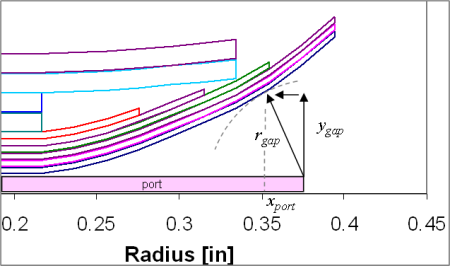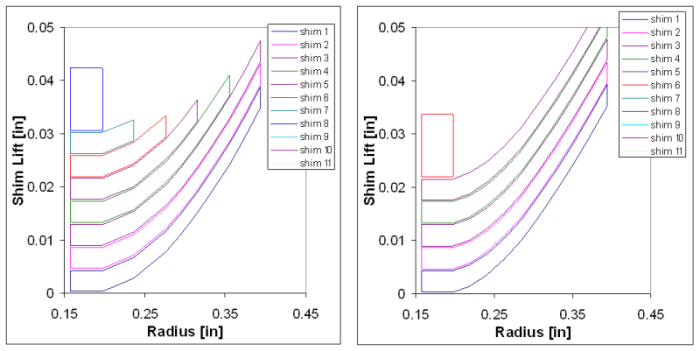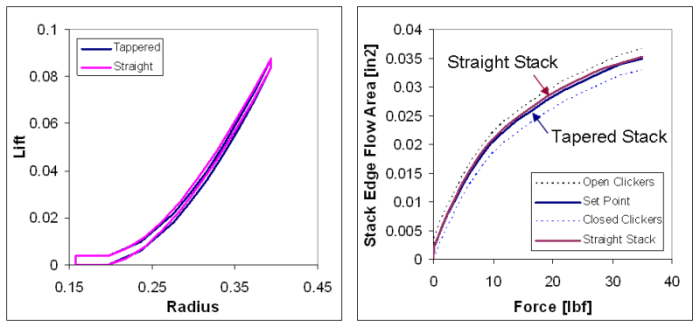


Stack Face Flow Area
Calculation of stack edge lift is inadequate to determine the fluid flow area between the valve face and shim stack. The actual flow area is a function of the valve port geometry and the bend profile of the face shim of the shim stack. ReStackor calculations accurately model these effects.
At low stack lift the edge lift and minimum gap are virtually the same. At higher stack lift the minimum flow area moves inward as a function of the stack bend radius. ReStackor carefully tracks this minimum flow area through integration of the area along the outside edge and side of the valve port to determine the actual flow area and the fluid flow resistance through the valve port. Accurate flow area accounting allows ReStackor to accurately compute flow resistance and the subtle effects of stack taper on the bend profile of the face shim and its impact on valve port flow resistance.
ReStackor uses the valve port geometry to determine the minimum gap area and integrates the flow area along the outside edge and side of the valve port.
The available flow area through the valve port is also sensitive to the valve port location. Moving the radial position of the valve port a millimeter one way of the other can significantly change the available flow area. Because of this sensitivity it is important for the ReStackor inputs to have accurate measurements of the valve port geometry when attempting comparisons with dyno test data.
![]()
Stack
taper effects on valve port flow area
The effect of the shim stack bend profile on valve port flow area can be demonstrated in ReStackor calculations through comparison of straight and tapered stacks. These two stacks have been custom tuned to provide exactly the same edge lift.
Stiffer root of taper stack produces less valve face flow area.
For a tapered stack there are fewer shims backing the outer edge of the face shim so the outer edge is softer. This produces slightly more lift at the outside edge and less lift near the stack hub. As a result a tapered stack has slightly less flow area when compared to a straight stack. Overlaying the face shims for these two stacks demonstrates the differences in bend profile. Comparison of the flow area computed by ReStackor over the range of stack lift for these two stack further illustrates this subtle difference. These differences change as a function of stack edge lift.
At the same edge lift a straight stack provides more flow area and softer damping.
Edge lift alone is inadequate to quantify the valve face flow area and fluid flow resistance. Shim ReStackor accounts for these effects by integrating the available flow area along the side and edge of the valve seat and reporting stack stiffness in terms of the flow area produced instead of edge lift. In addition this flow area comparison allows the effects of bleed clickers to be directly included in Shim ReStackor calculations. For the above tapered versus straight stack the differences in flow area is approximately equivalent 2 clicks on the bleed circuits. While this difference is small, a two click difference is frequently the effect riders are looking for when fine tune suspensions to balance low speed and high speed damping rates. The ReStackor calculations accurately capture these effects allowing you to accurately tune the stack configuration and control damping rates over the entire range of wheel speeds.



